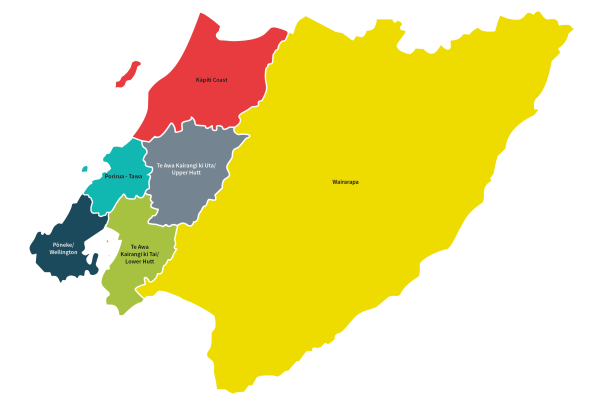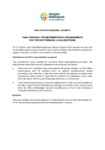Constituencies
Greater Wellington Regional Council currently has 13 councillors elected via a constituency system. The six constituencies represented by councillors are mapped below:
Representation arrangements for the 2025 triennial local elections
For the 2025 triennial local elections, Greater Wellington Regional Council will have 14 councillors, with:
- 13 elected members for six general constituencies with the same boundaries, names, and number of members as the current constituencies above; and
- One elected member for a single Māori constituency, covering the whole Wellington Region and named Te Upoko o te Ika a Māui Māori Constituency.
For more information, see the Local Government Commission’s Determination of Representation Arrangements for the 2025 Triennial Local Elections.
At these elections, Greater Wellington Regional Council must hold a binding poll of electors on whether the Māori constituency will continue for the following two triennial local elections.
Māori constituencies
The Local Electoral Act 2001 gives councils the ability to establish separate Māori constituencies for Māori electors.
Any separate Māori representation on Council under the Local Government Act 2002 is required to be based on enrolment on the Māori electoral roll.
Representation reviews
Councils are required to review their representation arrangements at least once every six years. This review must consider the:
- Number of elected members (within the legal requirement to have a minimum of six and a maximum of 14 members)
- Boundaries and names of each constituency
- Number of members that will represent each constituency.
Councils must follow the procedures set out in the Local Electoral Act 2001 when conducting their representation review. They should also follow the guidelines published by the Local Government Commission.
The Local Electoral Act 2001 provides the right to make a written submission to Council on its proposed representation arrangements, as well as the right to be heard if the submitter wishes. Submitters also have the right to appeal or object to Council’s final proposal. The Local Government Commission will then make a binding decision on the appeal.
Further details on the matters that councils must consider in reviewing their membership and basis of election can be found in the Local Electoral Act 2001.
2024 Representation Review
In 2024, Council conducted a review of its representation arrangements, and adopted its initial representation proposal on 27 August 2024.
Council adopted its final representation proposal for the 2025 triennial local elections on 31 October 2024. Council issued a related public notice (PDF 147 KB) and received two appeals. These appeals were forwarded to the Local Government Commission to determine the representation arrangements for Council by 10 April 2025.
FINAL PROPOSAL FOR REPRESENTATION ARRANGEMENTS FOR THE 2025 TRIENNIAL LOCAL ELECTIONS


date_range Published 31 Oct 2024
Download now (PDF 147 KB) get_appGet in touch
- Phone:
- 0800496734
- Email:
- info@gw.govt.nz
